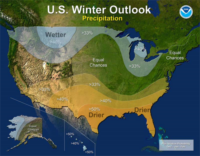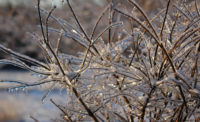La Nina, the climate phenomenon that sometimes appears in the fall and influences winter weather, is expected to have an effect this year, leading to warmer than normal conditions in the south and colder than usual temperatures in the north.
A warmer New England
The National Oceanic and Atmospheric Administration (NOAA) says that in addition to that southern swath, the central Rockies, Hawaii, western and northern Alaska and northern New England will also be on the warm side this winter.
The cooler areas will most likely be the northern tier from Montana to western Michigan. The rest of the country falls into the “equal chance” category, meaning that there is not a strong enough climate signal in these areas to shift the odds, so they have an equal chance for above, near-, or below-normal temperatures and/or precipitation.
The precipitation outlook will not come as good news to southern states that have seen drought conditions and wildfires for some time. Drier than normal conditions are most likely across the entire southern U.S. and southern Alaska, while wetter than normal conditions are most likely in the northern Rockies, around the Great Lakes, in Hawaii and in western Alaska.
The NOAA's drought predictions:
- Drought will likely persist through the winter in many regions currently experiencing drought, including much of California and the Southwest
- Drought is expected to persist and spread in the southeastern U.S. and develop in the southern Plains.
- New England will see a mixed bag, with improvement in the western parts and persistence to the east.
- Drought improvement is anticipated in northern California, the northern Rockies, the northern Plains and parts of the Ohio Valley.
“This climate outlook provides the most likely outcome for the upcoming winter season, but it also provides the public with a good reminder that winter is just up ahead and it’s a good time to prepare for typical winter hazards, such as extreme cold and snowstorms,” said Mike Halpert, deputy director, NOAA’s Climate Prediction Center. “Regardless of the outlook, there is always some chance for extreme winter weather, so prepare now for what might come later this winter.”
Other factors that often play a role in the winter weather include the Arctic Oscillation, which influences the number of arctic air masses that penetrate into the South and create nor'easters on the East Coast, and the Madden-Julian Oscillation, which can affect the number of heavy rain events in the Pacific Northwest.
A video of NOAA's 2016 winter outlook is available here.



